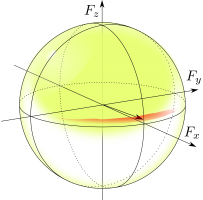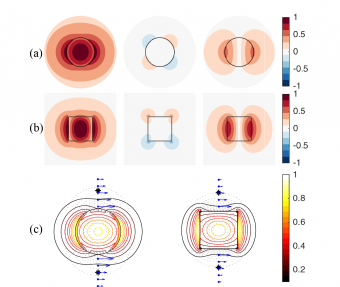Enhance atom-light coupling with a “weaker” local field
March 18, 2018 - Xiaodong Qi
Strong atom-light coupling is the key to quantum information processing with atoms and photons. It is a common belief that a strong optical field is required to generate a strong atom-light coupling. Following this school of thought, great challenges including heating and decoherent photon scattering problems have been encountered in experiments to enhance atom-light coupling by placing atoms in the strongest trapping field, which hindered the implementing of quantum communication and quantum computing applications using atoms. Surprisingly, a recent theoretical study conducted by researchers in CQuIC and the Sandia National Labs demonstrated that, by placing the atoms at an azimuthal position where the guided probe mode of a waveguide has the lowest intensity, the atom-light coupling is the strongest for quantum measurement applications.

In this study, the authors consider an atom-nanophotonic waveguide interface, where atoms are trapped in the evanescent field of a waveguide which has an effective diameter (a few hundred nano-meters) less than the wavelength of the light and supports two orthogonal guided modes. They use cooperativity to quantitatively characterize the atom-light coupling and study the enhancement of cooperativity in the atom-light interface near a nanophotonic waveguide for application to quantum nondemolition (QND) measurement of atomic spins.
Here the cooperativity per atom is determined by the ratio between the measurement strength and the decoherence rate. The two orthogonal guided modes are adiabatically connected to two orthogonal linearly polarized modes as the cross-section of the waveguide become large compared to optical wavelength. In the QND measurement protocol, as shown in the figure above, a horizontally polarized light is sent into the waveguide and becomes the H-mode in the interaction region where the atoms are trapped.
By preparing the trapped alkali atoms at a certain state known as a spin coherent state, the light detected at the measurement equipment will no longer be horizontally polarized due to the Faraday interaction with the atoms. How much the polarization state of the light is changed is a signature of the state of the collective spin of the atoms. Following the principles of quantum mechanics, when a measurement is done there is “backaction” on the state. 
By measuring the direction of the collective spin projected to the z-axis we dramatically reduced our uncertainty in this value from the superposition that existed in the initial spin coherent state. On the other hand, the uncertainty of the collective spin state projected to the orthogonal direction, the y-direction in this case, on the Bloch sphere has been elongated. This state is called a spin squeezed state, which has applications in precision measurements and other quantum information processing protocols. How much the spin is squeezing we can generation is determined by how strong the atoms are coupled to the probe light.
What is surprising about this study is that the authors discovered that the optimal configuration to generate the strongest spin squeezing effect is defined by placing the atoms at the weakest probe mode position, which is along the vertical direction–not the strongest mode position as the top 1 common guess of people–which is the horizontal direction in the xy-plane. This arises because the QND measurement strength relies on the interference between the probe and scattered light guided into an orthogonal polarization–V-mode, while the decoherence rate depends on the local intensity of the probe defined by the H-mode.
At the position of the atom the vacuum V-Mode is strongest. Thus, by placing the atoms on the y-axis, the ratio of good to bad scattering can be strongly enhanced for highly anisotropic modes. The researchers of this work apply this idea to study spin squeezing resulting from QND measurement of spin projection noise via the Faraday effect in two nanophotonic geometries, a cylindrical nanofiber and a square waveguide. They find, with about 2500 atoms using realistic experimental parameters, about 6.3 dB and 13 dB of squeezing can be achieved on the nanofiber and square waveguide, respectively. In contrast, to generate the same amount of spin squeezing using an atomic cloud trapped by Gaussian laser beams in free space, it might require billions of atoms.
 This study gives a new perspective on the design of the atom-nanophotonic waveguide interface. Based on the approach taken here, one can prepare and readout collective spin squeezing while avoiding strongly disturbing the mechanical motion and internal states of atoms, which are often big challenges if atoms are sitting at strong field spots of the probe. By using some additional techniques, such as adding an optical cavity on the waveguide, one can generate highly nonclassical nonGaussian states, which have a variety of applications in quantum information processing. This work also marks a milestone towards atom-nanophotonic interface based quantum simulations and quantum computing applications.
This study gives a new perspective on the design of the atom-nanophotonic waveguide interface. Based on the approach taken here, one can prepare and readout collective spin squeezing while avoiding strongly disturbing the mechanical motion and internal states of atoms, which are often big challenges if atoms are sitting at strong field spots of the probe. By using some additional techniques, such as adding an optical cavity on the waveguide, one can generate highly nonclassical nonGaussian states, which have a variety of applications in quantum information processing. This work also marks a milestone towards atom-nanophotonic interface based quantum simulations and quantum computing applications.
